| |
Short term, relative effectiveness of four doses versus three doses of BNT162b2 vaccine in people aged 60 years and older in Israel: retrospective, test negative, case-control study
|
| |
| |
Download the PDF here
5 May 2022
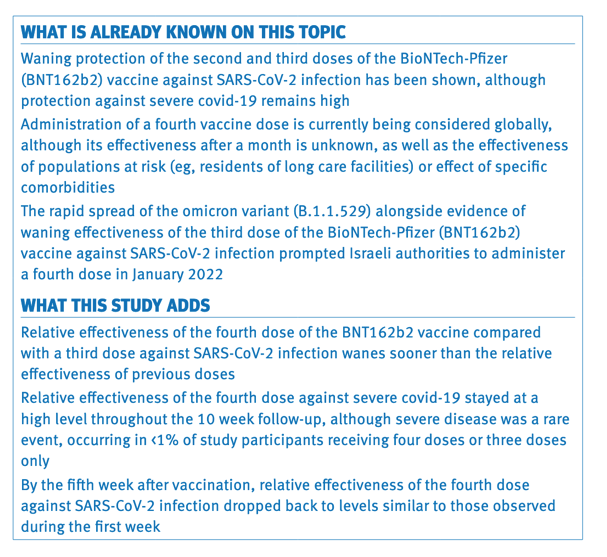
Conclusions and policy implications
The implications of our finding should be considered in the light of local and global vaccine resource allocation, as the fourth vaccine dose is deliberated in high risk older populations. This study has shown additional protection of the fourth dose against both SARS-CoV-2 infection and severe covid-19 relative to three doses. However, the relative vaccine effectiveness against infection varied over time and waned sooner than that of the third dose, by peaking at 65.1% three weeks after inoculation and falling to 22.0% by the end of the 10 week follow-up period. Relative effectiveness of a fourth dose against severe covid-19 stayed at a high level (>72%) throughout follow-up, although severe disease was a rare event, occurring in <1% of study participants receiving fourth doses or third doses only.
27 876 participants received the fourth BNT162b2 vaccine dose and 69 623 received three doses only. Of 106 participants who died during the follow-up period, 77 had had their third doses only and 23 had had their fourth doses during the first three weeks after inoculation. In the first three weeks, a fourth dose provided additional protection against both SARS-CoV-2 infection and severe disease relative to three doses of the vaccine. However, relative vaccine effectiveness against infection quickly decreased over time, peaking during the third week at 65.1% (95% confidence interval 63.0% to 67.1%) and falling to 22.0% (4.9% to 36.1%) by the end of the 10 week follow-up period. Unlike relative effectiveness against SARS-CoV-2 infection, the relative effectiveness of a fourth dose against severe covid-19 was maintained at a high level (>72%) throughout follow-up. However, severe disease was a relatively rare event, occurring in <1% of study participants who received four doses or three doses only.
Conclusions A fourth dose of the BNT162b2 vaccine appears to have provided additional protection against both SARS-CoV-2 infection and severe covid-19 disease relative to three vaccine doses. However, relative effectiveness of the fourth dose against infection appears to wane sooner than that of the third dose.
https://www.bmj.com/content/377/bmj-2022-071113
Relative effectiveness of the fourth dose against SARS-CoV-2 infection peaked in the second week of the outcome period (three weeks after inoculation) at 65.1% (95% confidence interval 63.0% to 67.1%) compared with those individuals vaccinated with only three doses (table 2, fig 1). However, the relative effectiveness began to decline in the fourth week, and by week 5 it dropped back to levels roughly similar to those observed during the first week, before reaching 22.0% (4.9% to 36.1%) by week 9.
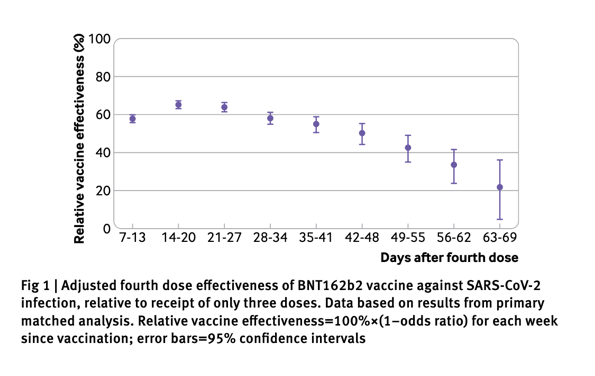
A total of 494 hospital admissions and deaths associated with covid-19 were matched to 2184 controls, where 80% of cases had five controls and 12.4% had two to four controls. Table 3 presents estimates of relative vaccine effectiveness per three week interval since receipt of the fourth dose; table S3 shows the adjusted odds ratios from which these estimates were derived. Unlike relative effectiveness against SARS-CoV-2 infection, relative effectiveness of a fourth dose against severe covid-19 did not vary significantly as a function of time since vaccination, reaching 86.5% (95% confidence interval 63.4% to 95%) compared with a third dose during weeks 6-9 of the outcome period (table 3, fig 2). Owing to the relative paucity of observations in the matched analysis, we also estimated relative effectiveness by dividing the outcome period into early and late intervals after inoculation, with similar estimates (tables S4-S5).

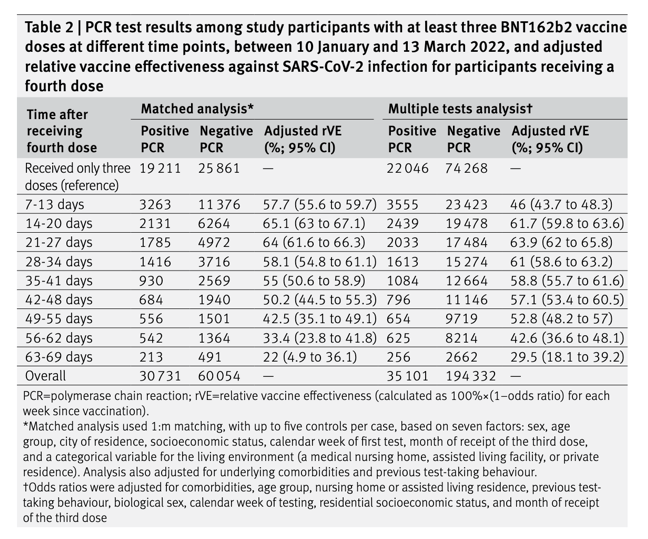
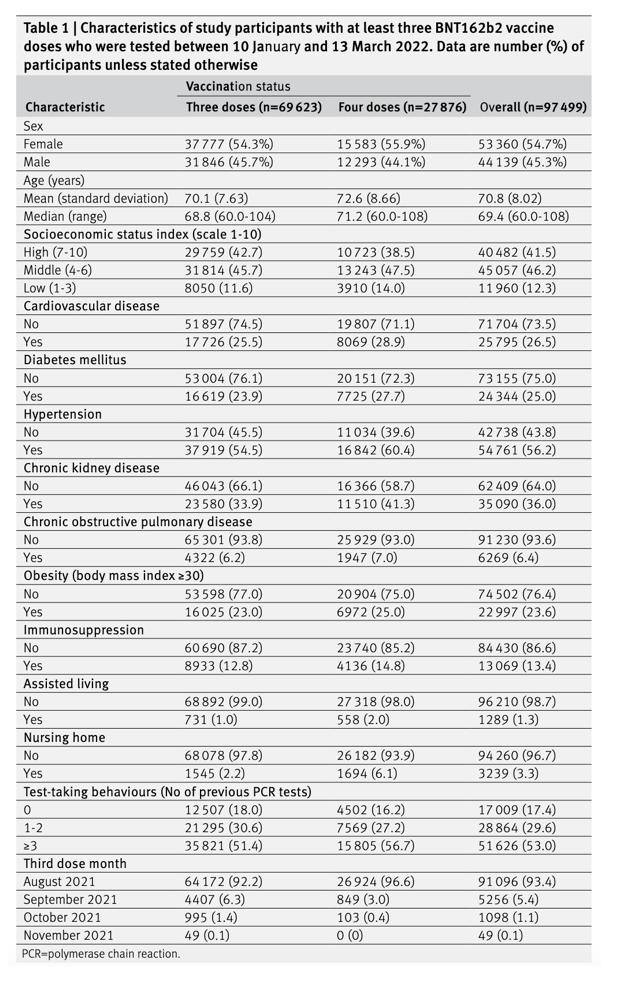
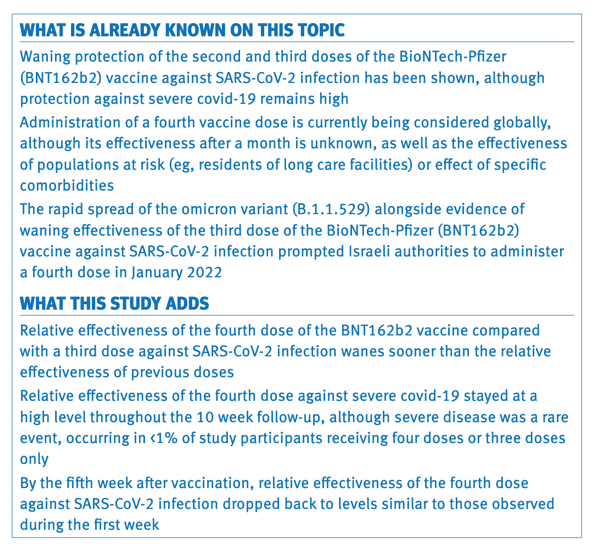
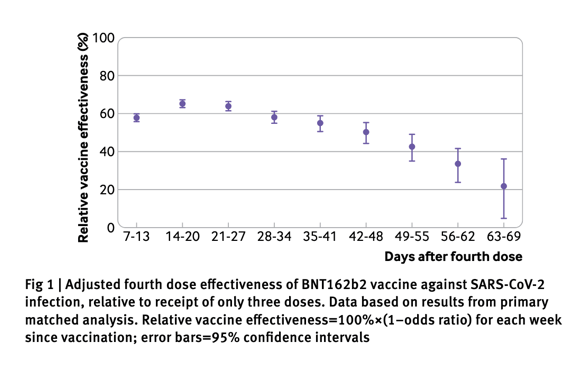

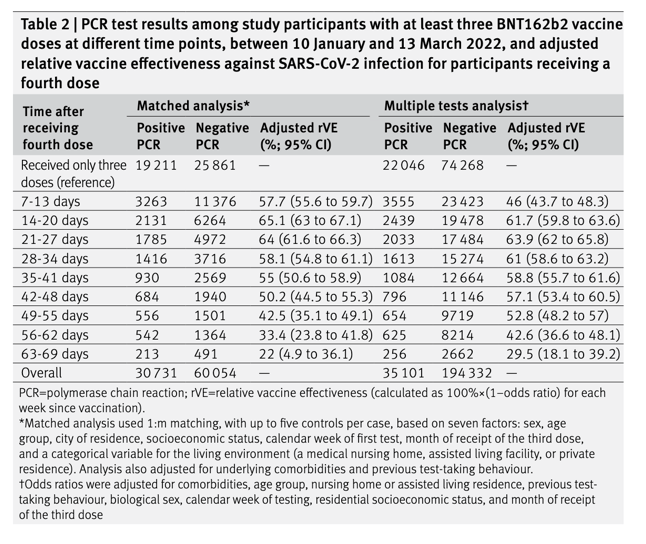
|
|
| |
| |
|
|
|